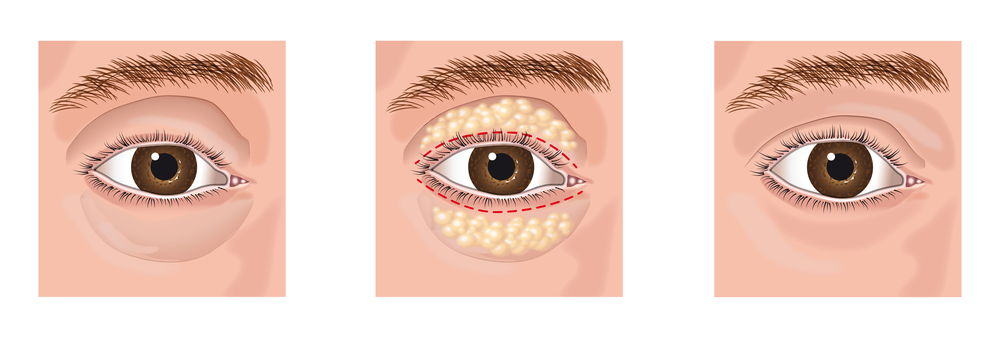Eyelid Surgery
With eyelid surgery, medically known as blepharoplasty, you can reduce the appearance of puffiness, bagginess, and signs of age around the eyes for a smoother, more refreshed aesthetic.
Here at New Eyes, we want to help patients who want to improve the way they look, in addition to the way they see. Blepharoplasty surgery can reduce the appearance of puffiness, bagginess, and signs of age around the eyes for a smoother, more refreshed aesthetic. This surgery can also remove areas of sagging skin from the upper eyelids that may be affecting your vision. This procedure is a very popular treatment that can have a positive effect on your entire facial appearance.
Please contact New Eyes for more information, or to schedule a consultation with Dr. P. Lloyd Hildebrand or Dr. Helga F. Pizio here at our practice.
- Types of Eyelid Surgery
- The Eyelid Surgery Procedure
- Eyelid Surgery Recovery
- Eyelid Surgery Results
- Eyelid Surgery Cost
- Complementary Procedures
- Eyelid Surgery FAQs
Blepharoplasty: Overview
What Are the Different Types of Eyelid Surgery?
Eyelid surgery, medically known as blepharoplasty, can rejuvenate both the upper and lower eyelid areas by removing excess fat, skin, and muscle tissue. The remaining skin is smoothed and tightened for a more youthful, refreshed appearance. The procedure can also be helpful for patients who experience sagging skin in the upper eyelids that is obstructing their field of vision.
Upper Blepharoplasty
Upper eyelid surgery can be beneficial for patients wishing to reduce excess skin that is obstructing vision. This procedure is also helpful for rejuvenating areas around the eyes that may be giving you a tired, aged appearance. This procedure is often medically necessary, and covered by most insurances.
Lower Blepharoplasty
Under-eye bags and puffiness can be addressed with lower eyelid surgery. The procedure is ideal for eliminating a “tired” appearance, and can ultimately help patients achieve a more revitalized and refreshed look. This procedure is not covered by insurance. At New Eyes, this procedure is performed by Dr. Hildebrand.
Ptosis: Overview
What Does the Blepharoplasty Procedure Entail?
Blepharoplasty procedures at New Eyes are customized for each patient, and are designed to address the upper eyelids, lower eyelids, or a combination of the two.
Upper eyelid surgery involves the removal of excess skin and then a tightening of the remaining eyelid surface. An eyelid crease incision is made to hide any scars, and the redundant skin is removed. The wound is closed to recreate the eyelid crease, resulting in a refreshed and more youthful look. Scarring from this procedure should not be noticeable when the eyes are open, since the incisions are very small and made in the crease of the upper lid.
For lower eyelid surgery, Dr. Hildebrand removes excess fat, skin, and muscle through a very small incision created under the lower eyelashes. The skin that remains will be smoothed and tightened for a more youthful and rested appearance. If only fat is removed, the incisions can be made on the inside of the eyelid, without visible scars.
A typical upper blepharoplasty is completed in 30-45 minutes, and a lower blepharoplasty can be performed in an additional 60-90 minutes. The specific length of the operation is dependent on the individual patient’s needs. The surgery is performed on an outpatient basis and patients are able to return home the same day.
What Is Eyelid Surgery Recovery Like?
Once eyelid surgery is complete, your eyelid incisions will be treated with a special antibiotic ointment. There will be some degree of bruising and swelling for several days after the procedure, and your eyes may feel sore or tight—however, any discomfort can be managed with applied ice packs. Please note that you may experience some temporary blurriness, tearing, and light sensitivity during recovery, but this should resolve quickly.
You will likely be able to resume normal daily activities after a few days, and most patients can return to work approximately 10-15 days after the procedure, or sooner, depending on your occupation. Additionally, you will be advised to avoid strenuous exercise/activities for at least two to three weeks after surgery. Less involved household activities such as reading, watching TV, or using the computer can usually be resumed almost immediately.
How Long Does Blepharoplasty Last?
After the healing process is complete, many patients experience the effects of eyelid surgery for as long as 10-15 years, depending on the individual. With good skin care habits, the results can be preserved even longer.
How Much Does Blepharoplasty Cost?
The average cost of eyelid surgery can vary, depending on your personalized treatment plan and individual insurance policy. There are a number of factors that can affect the overall cost, such as the amount of tissue that needs to be removed, as well as if any other procedure is needed in conjunction with the blepharoplasty. Additional considerations can include the surgeon’s fee, anesthesia, prescribed medications, and more.
To obtain a more accurate price estimate, please contact us today to schedule a consultation with one of our surgeons. Additionally, if you are interested in financing your eyelid surgery, we can provide you with information on how to apply for CareCredit®, a reputable healthcare lending company that enables qualified patients to make monthly payments with low or no interest.
Complementary Procedures
To maximize the benefits of your eyelid surgery, Dr. Hildebrand may recommend including complementary procedures as part of your treatment plan, such as brow lift surgery.
Patients who are seeking facial rejuvenation can benefit from combining upper and lower eyelid surgery, and may wish to include a brow lift as part of their procedure, as well. A brow lift can help smooth forehead creases and wrinkles for a more youthful appearance. When combined with upper and/or lower eyelid surgery, patients can achieve a more comprehensive result.
Other Frequently Asked Questions (FAQ) About Blepharoplasty
Will insurance cover eyelid surgery?
If the upper eyelid becomes so droopy that the resulting fold starts to obscure your vision, insurance may cover the partial or full amount of the procedure, depending on your insurance policy. Insurance typically doesn’t cover cosmetic surgery, but a droopy eyelid may be classified as a medical condition, and therefore may be eligible for coverage if your visual impairment is adequately documented. Specific tests are done and submitted to insurances for authorization, when applicable. A member of our team can talk more with you about potential insurance coverage once you have been examined.
When do I come in again for a follow-up visit?
Typically, a post-operative appointment is required 7-10 days after your surgery. If your procedure required stitches, our doctor will let you know in your first consultation visit whether they are dissolvable or if they will require removal. If applicable, your stitches will be removed 7-10 days post-operatively.
When will I see the results of my eyelid surgery?
While initial results are often apparent soon after surgery, the most optimal results of the procedure will take several weeks or months to become fully visible.
Will I have blepharoplasty scars?
Our surgeons take great care to place all incisions in locations that allow for any resulting scars to be nearly undetectable. For upper blepharoplasty, incisions are located in the crease of the upper eyelid, making them easily concealed, once healed. When performing lower blepharoplasty, Dr. Hildebrand utilizes a very small incision located beneath the lower eyelashes, which typically heals into a scar that blends in well with surrounding features. To ensure scars remain small and inconspicuous, we strongly recommend that you carefully follow all aftercare instructions from your surgeon and attend your follow-up appointments.
How can I reduce swelling after eyelid surgery?
Following your procedure, you may experience some mild swelling and/or bruising, but ice packs can be used to help manage any discomfort and reduce swelling. These side effects usually subside after about 7-10 days.
When can I wear contacts again after eyelid surgery?
You should avoid wearing contact lenses for at least two weeks following eyelid surgery. Your eye surgeon will let you know if this time needs to be extended.
When can I wear eye makeup after blepharoplasty?
Typically, it is best to refrain from wearing makeup on or around the eyes for at least two weeks after eyelid surgery (especially near the incision sites, which are particularly sensitive). However, we will provide you with personalized aftercare instructions that include more specific guidelines for your individual case.
Will eyelid surgery improve my vision?
If loose, hanging skin above the eyes has been causing vision obstruction, upper eyelid surgery can restore your field of vision for better eyesight. If you have additional vision concerns, please schedule an appointment for a thorough eye exam. Following your exam, our eye doctors can help you determine an appropriate treatment plan to improve your vision.
What is the difference between blepharoplasty and ptosis repair?
Although upper eyelid surgery can remove any excess skin that is causing vision obstruction, it is not designed to address drooping eyelids. Ptosis repair can help tighten a weakened muscle that lifts the upper eyelid, ultimately helping patients regain proper eyelid function.
If you would like more information on eyelid surgery (blepharoplasty), or if you would like to schedule a consultation with Dr. Hildebrand or Dr. Pizio, please contact New Eyes today.

